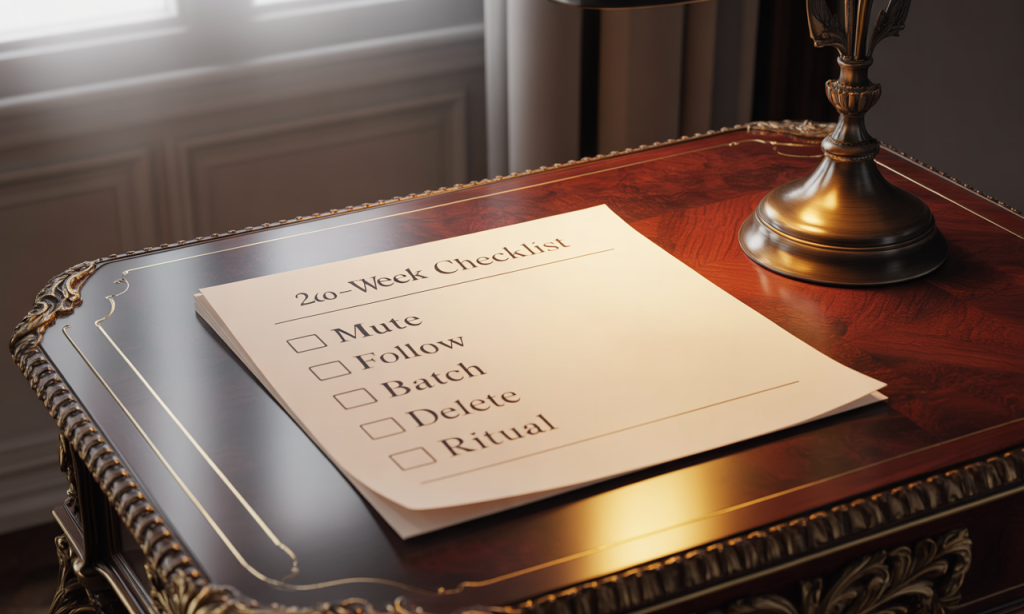Retrain Your Feed: Edit Digital Inputs That Undercut Love

Your feeds shape your feelings. What you scroll before breakfast and after bedtime is quietly training your nervous system—either toward patience, gratitude, and quick repair, or toward sarcasm, suspicion, and hair-trigger arguments. Retrain Your Feed is a simple, repeatable way to curate digital inputs that reward repair, humility, and calm so conflicts cool faster and connection comes easier. Inputs drive outputs. Choose wisely.
 If you want to see how environment—digital and physical—steers behavior at home, pair this with a systems view in How We Built This (Mess) and then try some gentle location shifts from New Places, New People.
If you want to see how environment—digital and physical—steers behavior at home, pair this with a systems view in How We Built This (Mess) and then try some gentle location shifts from New Places, New People.
Why Retrain Your Feed Works (Inputs Train Your Nervous System)
 Behavior follows context, and your phone is a portable context. Fast cuts, outrage bait, and contempt-as-comedy raise arousal; gratitude, kindness, and repair scripts lower it. Scroll enough contempt, and your body enters conversations already braced to defend; scroll enough repair and humility, and it arrives to listen.
Behavior follows context, and your phone is a portable context. Fast cuts, outrage bait, and contempt-as-comedy raise arousal; gratitude, kindness, and repair scripts lower it. Scroll enough contempt, and your body enters conversations already braced to defend; scroll enough repair and humility, and it arrives to listen.
That’s why Retrain Your Feed is powerful: change what you repeatedly consume, and you change what you reflexively produce. If you’re practicing go-first leadership at home, this move multiplies your efforts; learn the tone and boundary posture in Lead Without Permission so your off-screen choices match your on-screen diet.
The Retrain Your Feed Audit: What’s Training You Now?
 Before you edit, notice the inputs currently running the show. Open your top three platforms and sample the last 20 items on each. Mark each item with one of five tags:
Before you edit, notice the inputs currently running the show. Open your top three platforms and sample the last 20 items on each. Mark each item with one of five tags:
- Repair (models apology, empathy, boundaries)
- Upregulate (anger bait, cynicism, contempt)
- Downregulate (calm, gratitude, beauty, humor without meanness)
- Escape (mindless, not harmful, but long sessions leave you numb)
- Envy/Compare (status or perfection snapshots that sour your day)
Now ask: What proportion of my feed cues defensiveness vs. connection? If most of your stream is either outrage or perfection, your relationship will feel more fragile by dinner.
If you’d like help creating offline contexts to match your edited feeds, the step-by-step ideas in New Places, New People will make connection easier in the rooms you already live in.
Five Inputs That Quietly Undercut Love (and What to Swap In)
- Contempt-as-entertainment
Swap in: accounts that normalize clean apology, small affection, and no-drama boundaries. Pair with Apologize Right to practice those moves at home. - Doomscrolling outrage
Swap in: one or two trusted news digests time-boxed to a window (e.g., 10 minutes at lunch), and two beauty/quiet accounts that downshift your nervous system. - “Team Single, Dump ’Em” advice (when you’re committed to repair)
Swap in: skilled counselors and couples who model kindness and accountability. If a clip raises red flags for you, keep your safety lens sharp via Friction Isn’t Abuse. - Comparison reels
Swap in: gratitude prompts, service ideas, or simple family rhythms. Then practice a weekly reliability routine from Say Less, Do More so your real life outshines the highlight reels. - Conspiracy echo chambers that leave you agitated and mistrustful
Swap in: long-form learning and accounts that emphasize curiosity and humility. When you feel a spike, walk through Trigger to Teacher to convert defensiveness into a next step.
The 14-Day Retrain Your Feed Reset (Simple, Repeatable, Kind)
 You don’t need a personality transplant; you need two disciplined weeks. This plan is humane—no moralizing, just small swaps that accumulate.
You don’t need a personality transplant; you need two disciplined weeks. This plan is humane—no moralizing, just small swaps that accumulate.
Days 1–2: Snapshot and Sift
- Screenshot each platform’s home feed.
- Mute five accounts that reliably spike contempt.
- Follow five that model repair and gratitude.
- Time-box two “news windows” (e.g., 8:00–8:15 a.m., 12:30–12:40 p.m.).
Days 3–4: Quiet Your Mornings and Evenings
- Move your phone out of reach in bed; put a paper book or prayer/journal where the phone used to sit.
- Create a bedtime playlist (10 minutes) that signals your brain to downshift.
Days 5–6: Create a “Repair Playlist” of Accounts
- Build a saved list titled “Repair” with apology scripts, boundary phrases, and playful date prompts.
- During tense days, open the list for two minutes before hard talks. To anchor the tone, rehearse the 90-second reset from Non-Reactive Strength.
Image suggestion: a saved “Repair” collection open on a phone—apology templates, calm breathing clips
Alt text: repair playlist on social showing apology and calm tools ready before a tough talk
Days 7–8: Batch Notifications and Delete One App (Temporarily)
- Turn off push notifications for all but essentials (calls, messages, calendar).
- Delete the platform most likely to hijack your mood; access it from a browser only.
Days 9–10: Add One Long-Form Input
- Replace 20 minutes of reels with one thoughtful article, sermon, guided prayer, or chapter.
- Share one sentence out loud at dinner: “This line stuck with me…”
Days 11–12: Curate Group Threads
- Rename a family thread to set tone: “Kind Updates Only 😊.”
- Offer one gentle nudge when the thread overheats: “Pressing pause—love you all.”
Days 13–14: Review, Lock, and Link to Real Life
- Keep the helpful follows; unfollow three more agitators.
- Bring your new tone into a small ritual: a porch reset or walk-and-talk from New Places, New People.
The Digital Diet That Supports Calm (Timing, Tempo, and Tone)
 Food rules that work in real life are flexible, visible, and kind. Digital rules should be the same:
Food rules that work in real life are flexible, visible, and kind. Digital rules should be the same:
- Windows, not constant grazing: two short news windows, one evening scroll window—done.
- Pair scrolling with posture: sit upright with feet down; slouching + endless feeds = numb agitation.
- Tone trigger: the moment you feel your jaw clench, stop, breathe out longer than in, and close the app. That is non-reactive leadership in your thumbs.
If you’re carrying the invisible “house vibe” job alone, protect fairness with shared systems in Beyond 50/50—shared minimums, visible tasks, weekly rebalancing—so your curation work isn’t one more uncredited task.
Couples’ Retrain Your Feed Pact (Fair, Warm, and Winnable)
 Make the media load visible and fair without becoming the phone police.
Make the media load visible and fair without becoming the phone police.
- Shared minimums: no phones at dinner, 10-minute wind-down playlist, two weekly phone baskets in the living room.
- Gentle cue: a small card that says “Back in 10?” placed near your spouse when you need a reset.
- Rebalance meeting: 20 minutes on Sunday (wins, roadblocks, shift duties). Template in Say Less, Do More.
If you’re starting first and your spouse isn’t ready yet, model it at a sustainable pace using the cadences from Patient Leadership.
Scripts You Can Use Today (Mute, Unfollow, and Nudge with Grace)
 To yourself (boundary script):
To yourself (boundary script):
“I can feel this pulling me toward snark. I’m pausing for 90 seconds and closing the app.”
To a friend (DM nudge):
“Love your courage. I’m trying to keep my feeds repair-focused, so I’m muting some topics for a bit. Cheering you on.”
In a family thread:
“Taking a breath—this is getting spicy. I care about all of you; I’m muting for the evening. Let’s restart tomorrow.”
If the pushback you’re getting feels like pressure to abandon your values, tighten your boundary kindly. If it feels unsafe (threats, coercion), your next step is safety, not more effort—see When It’s Actually Abuse.
Link Your Retrain Your Feed to Off-Screen Change
 Changing your inputs is step one; changing your outputs requires practice. Stack these:
Changing your inputs is step one; changing your outputs requires practice. Stack these:
- Before hard talks: open your “Repair” playlist and run a 90-second reset from Non-Reactive Strength.
- After a slip: use the 60-second template in Apologize Right.
- Weekly rhythm: use Say Less, Do More to turn intentions into calendar entries.
- Momentum markers: track 30/60/90 days with Consistency Clock (fewer escalations, faster repairs, more turn-toward moments).
Group Chats, Comment Sections, and the “Hot Room” Effect
 Some rooms are hot by design. If you must be there, bring ventilation:
Some rooms are hot by design. If you must be there, bring ventilation:
- Rename the thread to set tone (Kind Updates / Logistics Only).
- Move sensitive topics to a calmer channel (voice note, 1-to-1 call).
- Install a pause norm: “Back in 10—grabbing water.”
- Exit if needed: “I’m out for the night—love you.”
When a room is chronically hot (mockery, group shaming, pressure to overshare), protect yourself. Ordinary friction is normal; humiliation and intimidation are not. Learn the difference in Friction Isn’t Abuse and act accordingly.
Handling Cravings, Setbacks, and “Just One More Swipe”
 The algorithm is designed to keep you there. Expect cravings. Treat them like any habit change:
The algorithm is designed to keep you there. Expect cravings. Treat them like any habit change:
- If–then plans: “If I open the app outside my window, then I close it and take 5 breaths.”
- Friction helps: log out after each session; move the app to a hidden page.
- Replacement matters: keep a paper book, crossword, or prayer app on your first screen.
If you relapse, don’t catastrophize—repair your plan. Tweak one variable (timing, triggers, or replacements). New inputs plus patient leadership off-screen is a strong combo; see Patient Leadership for humane pacing when your motivation dips.
Measure What Matters (and Celebrate What Improves)
 Choose three momentum markers and track them for a month:
Choose three momentum markers and track them for a month:
- Time from conflict to repair (goal: shrinking toward same-day)
- Number of escalations per week (goal: shrinking)
- Turn-toward moments (eye contact, small help, affectionate texts) (goal: rising)
Share progress sparingly, and only to support connection (“I noticed we repaired fast twice this week—felt good”). For structure and celebration ideas, use Consistency Clock and Celebrate the Small Joins.
Make Calm Touristy: New Places, New People to Match Your New Inputs
 When your digital diet cools off, you’ll feel an urge to be in calmer rooms with kinder people. Ride that wave. Try a walk-and-talk, a bookstore lap, or coffee with a couple who repairs quickly. The guide New Places, New People gives you scripts and a 30-day plan.
When your digital diet cools off, you’ll feel an urge to be in calmer rooms with kinder people. Ride that wave. Try a walk-and-talk, a bookstore lap, or coffee with a couple who repairs quickly. The guide New Places, New People gives you scripts and a 30-day plan.
Frequently Asked Questions
 Isn’t muting just an echo chamber?
Isn’t muting just an echo chamber?
Not when your goal is character, not ideology. You’re curating for repair skills and humility across perspectives, not insulating yourself from ideas. Diversity of thought is welcome; contempt isn’t.
What if my spouse won’t edit their feeds?
You can start solo. Your steadiness changes the system (less escalation, faster repair). If you’re worried about becoming the default manager, create fairness with Beyond 50/50—shared minimums and weekly rebalancing.
What if a friend is hurt that I muted them?
Offer a kind explanation if needed: “I’m curating for calm while we work on some goals. I care about you.” You owe no defense beyond that. If they retaliate, revisit your safety lens.
Does this replace counseling or faith practices?
No, it supports them. A calmer nervous system makes prayer, counseling, and honest talk more effective.
When do I worry that the problem isn’t the feed but the relationship?
If you’re facing coercion, humiliation, threats, or harm, stop optimizing the algorithm and choose safety. Read When It’s Actually Abuse and seek support.
A Closing Word: Inputs Drive Outputs—Choose Wisely
 Retrain Your Feed doesn’t demand perfection; it asks for stewardship. Five better follows. Five polite mutes. Two time windows. One “Repair” playlist. That’s enough to change the weather in your home. Then stack real-world habits on top—clean apologies, non-reactive breath, fair systems—and you’ll feel the difference where it counts most.
Retrain Your Feed doesn’t demand perfection; it asks for stewardship. Five better follows. Five polite mutes. Two time windows. One “Repair” playlist. That’s enough to change the weather in your home. Then stack real-world habits on top—clean apologies, non-reactive breath, fair systems—and you’ll feel the difference where it counts most.
When you’re ready to extend these changes offline, take a next step with New Places, New People: Environments That Make Connection Easier—a natural companion to the digital reset you just began.


